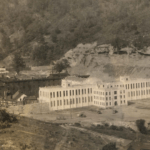Brushy Mountain State Penitentiary last named Brushy Mountain Correctional Complex (also called Brushy) was a large maximum-security prison in the town of Petros in Morgan County, Tennessee, operated by the Tennessee Department of Correction. It was established in 1896 and operated until 2009. The grounds of the prison are now included in part of the Barkley Marathons.
History
The end of the Civil War led to a boom in railroad construction and the rapid expansion of the coal mining industry throughout Tennessee. Because many of the state’s coal veins were located in remote areas, most mining companies providing housing by collecting rent from miners’ wages.
When those companies opened onsite stores selling food, clothes and other necessities at inflated prices, already poor workers piled up debt. By the time their debt and rent were paid, they had little to show for a meager wage job with dangerous working conditions.
The prison lease system was adopted throughout the South mainly because state governments couldn’t afford to build and maintain prisons or feed, shelter and clothe inmates and a convict lease program cut costs and brought in money. Beyond that, officials could exploit the Thirteenth Amendment, which abolished slavery but allowed “involuntary servitude” for criminal punishment.
This fateful decision led to the Coal Creek War, where citizen-miners attacked and burned the state prison, stockades and mines, then loaded prisoners and guards alike onto a train headed out of town. When months of small-arms skirmishes led to dead men on both sides, officials realized the cost of maintaining a standing militia undercut any financial gains and as convict-lease contracts expired, legislation passed to construct the state’s first maximum security prison – Brushy Mountain State Penitentiary.
By 1896, inmates were building an onsite railroad spur, as well as the original wooden prison structure with their own hands. Between the ongoing violence, deadly mining accidents and chronic illness, life inside Brushy was precarious to say the least. Diseases were rampant, including tuberculosis, typhoid fever, pneumonia, and syphilis – which alone affected 3/4 of the black prisoners. Beyond generally poor medical care and treatment, inmates were routinely beaten for “underproducing” in the mines, despite their dire health conditions, and many died as a result.
In 1931, Brushy held nearly a thousand inmates, far more than it was ever meant to. Overcrowding was so prevalent and persistent it drew comparisons to conditions inside the infamous Siberian prisons of the Soviet Union. The state’s answer was simple. Plans were drawn for a new structure to be made of reinforced concrete and they made convicts break sandstone out of the nearby quarry to build the new prison. Constructed in the shape of a Greek cross, it stood four stories high, boasted battlements atop and by 1934 was surrounded by an 18-foot stone wall.
By the middle of the century, Brushy’s reputation as the last stop for the worst criminals had become legend. If you wore out your welcome at another prison or committed some unspeakable crimes, you ended up at Brushy. In ‘82, the powder keg ignited. Seven white inmates held guards hostage at knifepoint. They took the guards’ guns, found four of their black rivals in their locked cells and opened fire. They killed two. The other two managed to survive by hiding in the corner behind their mattresses.
Supposed Hauntings
Evil men who did evil things were imprisoned here, with many locked away for the rest of their lives. And while the death penalty was never carried out at Brushy, more than a few died of natural causes or in the mines. Others met their end with the blade of a meat cleaver or a shiv, the final blow delivered by the violent hands of fellow inmate.
These are the souls that haunt this stone-cold fortress, whose spirits refuse to cross over. Who remain here because they have unfinished business. Paranormal activity includes apparitions, shadows, disembodied voices, unexplained loud bangs, growls, and physical attacks. Visitors have been touched, shoved, scratched and gotten EVP and EMF evidence.
